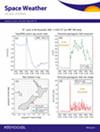Substorm-Time Ground dB/dt Variations Controlled by Interplanetary Shock Impact Angles: A Statistical Study
IF 3.7
2区 地球科学
引用次数: 0
Abstract
In this study, we investigate the effects caused by interplanetary (IP) shock impact angles on the subsequent ground dB/dt variations during substorms. IP shock impact angles have been revealed as a major factor controlling the subsequent geomagnetic activity, meaning that shocks with small inclinations with the Sun-Earth line are more likely to trigger higher geomagnetic activity resulting from nearly symmetric magnetospheric compressions. Such field variations are linked to the generation of geomagnetically induced currents (GICs), which couple to artificial conductors on the ground leading to deleterious consequences. We use a sub-set of a shock data base with 237 events observed in the solar wind at L1 upstream of the Earth, and large arrays of ground magnetometers at stations located in North America and Greenland. The spherical elementary current system methodology is applied to the geomagnetic field data, and field-aligned-like currents in the ionosphere are derived. Then, such currents are inverted back to the ground and dB/dt variations are computed. Geographic maps are built with these field variations as a function of shock impact angles. The main findings of this investigation are: (a) typical dB/dt variations (5–10 nT/s) are caused by shocks with moderate inclinations; (b) the more frontal the shock impact, the more intense and the more spatially defined the ionospheric current amplitudes; and (c) nearly frontal shocks trigger more intense dB/dt variations with larger equatorward latitudinal expansions. Therefore, the findings of this work provide new insights for GIC forecasting focusing on nearly frontal shock impacts on the magnetosphere.受行星际冲击角度控制的次风暴时间地面 dB/dt 变化:统计研究
在这项研究中,我们调查了行星际(IP)冲击角对随后亚暴期间地面 dB/dt 变化的影响。行星间冲击角是控制后续地磁活动的一个主要因素,这意味着与日地线倾角较小的冲击更有可能触发近乎对称的磁层压缩所产生的较高地磁活动。这种磁场变化与地磁感应电流(GIC)的产生有关,GIC 与地面上的人造导体耦合,导致有害后果。我们使用了冲击数据库中的一个子集,其中包括在地球上游 L1 太阳风中观测到的 237 个事件,以及位于北美和格陵兰站的大型地面磁强计阵列。将球形基本电流系统方法应用于地磁场数据,并推导出电离层中的场对齐样电流。然后,将这些电流反演回地面,并计算出 dB/dt 变化。利用这些作为冲击角函数的场变化绘制地理图。这项研究的主要发现有(a) 典型的 dB/dt 变化(5-10 nT/s)是由中等倾角的冲击造成的;(b)冲击越是正面,电离层电流振幅就越强烈,空间范围也越明确;(c)近正面的冲击会引发更强烈的 dB/dt 变化,赤道纬度扩展更大。因此,这项工作的发现为侧重于近正面冲击对磁层的 GIC 预测提供了新的见解。
本文章由计算机程序翻译,如有差异,请以英文原文为准。
求助全文
约1分钟内获得全文
求助全文

 求助内容:
求助内容: 应助结果提醒方式:
应助结果提醒方式:


